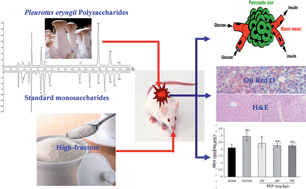Chemical composition of Pleurotus eryngii polysaccharides and their inhibitory effects on high-fructose diet-induced insulin resistance and oxidative stress in mice
Abstract
High intake of dietary fructose exerts a number of adverse metabolic effects. The present study investigates the preventive effects of Pleurotus eryngii polysaccharides (PEP), which showed powerful antioxidant activity in vitro, on insulin resistance and oxidative stress in mice fed a high-fructose diet. PEP was identified by HPLC as the heteropolysaccharides with D-glucose (62.8%, mol%), D-galactose (24.4%) and D-mannose (9.8%) being the main component monosaccharides. Mice fed 20% fructose in drinking water for 6 weeks significantly displayed hyperglycemia, hyperinsulinemia, dyslipidemia and liver oxidative stress with impaired insulin sensitivity (p < 0.05). The administration of PEP at 400 and 800 mg kg−1 bw significantly reduced the fasting serum glucose and insulin concentrations and lipid deposition in HF-fed mice, and caused the reduction of liver lipid peroxidation and the elevation of the hepatic antioxidant system. The histopathology of the liver by conventional H&E and oil red O staining confirmed the liver steatosis induced by a HF diet and the hepatoprotective effect of PEP. These results suggest that Pleurotus eryngii is a potential source of polysaccharides, and might be regarded as a novel preventive and therapeutic product for the mitigation of insulin resistance, oxidative stress and liver dysfunction.


 Please wait while we load your content...
Please wait while we load your content...